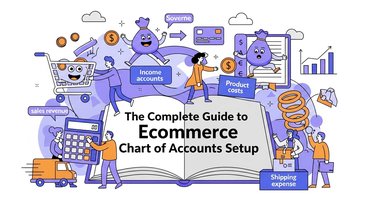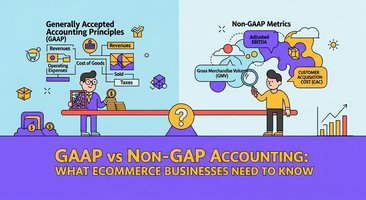Running a successful ecommerce business requires making smart financial decisions from day one. One of the most important choices you'll face is selecting the right accounting method. Should you use cash accounting or accrual accounting?
This decision affects everything from your tax obligations to how you track inventory and manage cash flow. The wrong choice can lead to compliance issues, inaccurate financial reporting, and missed opportunities for growth.
In this comprehensive guide, we'll explore both accounting methods, their pros and cons for ecommerce businesses, and help you determine which approach best suits your online store.
What is Cash Accounting?
Cash accounting is the simpler of the two methods. With cash accounting, you record transactions only when money actually changes hands. Revenue is recognized when you receive payment from customers, and expenses are recorded when you pay them.
For example, if you sell a product in December but don't receive payment until January, you'd record that sale in January under cash accounting.
Key Features of Cash Accounting:
- Simple to understand and implement
- Records transactions based on actual cash flow
- No need to track accounts receivable or payable
- Immediate reflection of your actual cash position
- Preferred method for very small businesses
Benefits of Cash Accounting for Ecommerce:
- Simplicity: Easy to manage without extensive accounting knowledge
- Cash Flow Clarity: Shows exactly how much cash you have available
- Tax Advantages: You only pay taxes on money you've actually received
- Lower Compliance Costs: Minimal bookkeeping requirements
- Real-Time Cash Position: Always know your actual cash availability
Limitations of Cash Accounting:
- Limited Financial Insight: Doesn't show the complete financial picture
- Poor Growth Planning: Makes it difficult to forecast future performance
- Inventory Challenges: Can't properly track cost of goods sold
- Investor Concerns: Most investors prefer accrual-based financial statements
- IRS Restrictions: Not allowed for larger businesses or those with inventory
What is Accrual Accounting?
Accrual accounting records transactions when they occur, regardless of when payment is made or received. Revenue is recognized when you make a sale, and expenses are recorded when you incur them.
Using the same example, if you sell a product in December, you'd record that sale in December under accrual accounting, even if payment doesn't arrive until January.
Key Features of Accrual Accounting:
- Records transactions when they occur, not when paid
- Matches revenues with related expenses in the same period
- Provides a more accurate picture of business performance
- Required for larger businesses and those with inventory
- Uses accounts receivable and accounts payable
Benefits of Accrual Accounting for Ecommerce:
- Accurate Performance Measurement: Shows true profitability by matching revenues and expenses
- Better Business Planning: Provides clearer insights for forecasting and growth planning
- Professional Financial Statements: Creates investor-ready financial reports
- Inventory Management: Properly tracks cost of goods sold and inventory values
- Compliance Ready: Meets requirements for larger businesses and audits
Limitations of Accrual Accounting:
- Complexity: Requires more sophisticated bookkeeping knowledge
- Cash Flow Confusion: Profit doesn't always equal available cash
- Higher Costs: May require professional accounting help
- Tax Implications: You pay taxes on earned income, even if not yet collected
- More Recordkeeping: Requires tracking receivables and payables
IRS Requirements: When You Must Use Each Method
The IRS has specific rules about which accounting method you can use:
Cash Method Requirements:
- Average gross receipts under $27 million over the past 3 years
- No inventory requirements (with exceptions for small businesses)
- Not a C corporation (except qualified personal service corporations)
- Not a partnership with C corporation partners
Accrual Method Requirements:
- Average gross receipts over $27 million in the past 3 years
- Businesses that maintain inventory (with small business exceptions)
- C corporations (except qualified personal service corporations)
- Partnerships with C corporation partners
Small Business Exception:
Thanks to the Tax Cuts and Jobs Act, small businesses with average annual gross receipts of $27 million or less can:
- Use cash accounting even with inventory
- Treat inventory as "non-incidental materials and supplies"
- Avoid complex uniform capitalization rules
- Choose the method that works best for their business
Ecommerce-Specific Considerations
Inventory Management:
Cash Accounting: Traditionally required accrual method for inventory, but small business exception now allows cash method treatment
Accrual Accounting: Provides accurate cost of goods sold calculation and inventory valuation
Multi-Channel Sales:
Cash Accounting: Simple tracking across platforms, but may not show complete sales performance
Accrual Accounting: Better for tracking performance across Amazon, eBay, Shopify, and other channels
Returns and Refunds:
Cash Accounting: Records refunds when cash is returned to customer
Accrual Accounting: Requires adjustment entries to reverse original sale recognition
Seasonal Businesses:
Cash Accounting: May show misleading profitability during slow periods
Accrual Accounting: Provides more consistent view of business performance
Tax Implications of Each Method
Cash Method Tax Benefits:
- Pay taxes only on money actually received
- Can defer income by delaying invoicing near year-end
- Immediate deduction for expenses when paid
- Simpler tax preparation process
Accrual Method Tax Considerations:
- Pay taxes on all earned income, regardless of collection
- More complex tax calculations
- May require estimated tax payments
- Better matching of income and expenses for tax purposes
Strategic Tax Planning:
With cash accounting, you have more control over the timing of income and expenses for tax purposes. Accrual accounting provides less flexibility but more accurate business performance measurement.
Making the Right Choice for Your Business
Choose Cash Accounting If:
- You're a small ecommerce business under $27 million in revenue
- You want simple bookkeeping and lower compliance costs
- Cash flow management is your primary concern
- You don't need detailed financial statements for investors
- You prefer paying taxes only on money actually received
Choose Accrual Accounting If:
- You need accurate financial statements for investors or lenders
- You want better business performance insights
- You're planning rapid growth or expansion
- You need to track complex inventory and cost of goods sold
- You're required by IRS rules due to business size
Hybrid Approach:
Some businesses use a hybrid method, combining elements of both:
- Cash method for most transactions
- Accrual method for inventory and cost of goods sold
- Requires IRS approval and consistent application
How Klavena Simplifies Both Accounting Methods
Whether you choose cash or accrual accounting, Klavena's ecommerce accounting platform makes implementation seamless:
For Cash Accounting:
- Real-Time Cash Tracking: Monitor actual cash flow across all sales channels
- Payment-Based Recognition: Automatically records revenue when payments are received
- Simple Expense Tracking: Records expenses when actually paid
- Tax-Ready Reports: Generates cash-based reports for tax preparation
For Accrual Accounting:
- Automated Revenue Recognition: Records sales when transactions occur
- Accounts Receivable Management: Tracks outstanding customer payments
- Expense Matching: Matches expenses with related revenues in the same period
- Professional Financial Statements: Creates investor-ready balance sheets and income statements
Universal Benefits:
- Multi-Channel Integration: Works with Amazon, Shopify, eBay, and 50+ platforms
- Automated Bookkeeping: Reduces manual data entry by up to 95%
- Real-Time Reporting: Instant access to financial insights
- Tax Compliance: Ensures accurate reporting regardless of chosen method
- Scalable Solution: Grows with your business as accounting needs evolve
Switching Between Methods
When to Consider Switching:
- Business growth exceeds IRS thresholds
- Need for more detailed financial reporting
- Investor or lender requirements
- Changes in business complexity
How to Switch:
- File Form 3115 (Application for Change in Accounting Method)
- May require IRS approval
- Consider timing for tax implications
- Update all financial systems and processes
Klavena's Switching Support:
Our platform makes accounting method transitions seamless with automated data conversion and compliance support.
Best Practices for Implementation
Getting Started:
- Assess Your Business: Evaluate size, complexity, and growth plans
- Consult Professionals: Work with accountants familiar with ecommerce
- Choose Your Platform: Select accounting software that supports your chosen method
- Establish Procedures: Create consistent processes for transaction recording
- Monitor Compliance: Regularly review IRS requirements and business changes
Ongoing Management:
- Maintain consistent application of chosen method
- Regular review of business growth and IRS thresholds
- Keep detailed records for all transactions
- Plan for potential method changes as business grows
Common Mistakes to Avoid
Cash Accounting Mistakes:
- Mixing cash and accrual recognition
- Poor cash flow forecasting
- Inadequate inventory tracking
- Improper timing of income and expenses
Accrual Accounting Mistakes:
- Ignoring cash flow implications
- Inconsistent revenue recognition
- Poor accounts receivable management
- Inadequate expense matching
Universal Mistakes:
- Inconsistent method application
- Poor record keeping
- Ignoring IRS requirement changes
- Lack of professional guidance
Conclusion
Choosing between cash and accrual accounting is a critical decision that impacts every aspect of your ecommerce business. Cash accounting offers simplicity and cash flow clarity, while accrual accounting provides comprehensive business insights and professional financial reporting.
For most small to medium ecommerce businesses, the choice comes down to your specific needs:
- Growing businesses benefit from accrual accounting's detailed insights
- Simple operations may prefer cash accounting's ease of use
- Investor-funded businesses typically require accrual accounting
- Bootstrap startups often start with cash accounting
Regardless of your choice, the key is consistent application and proper implementation. With the right accounting method and tools like Klavena, you'll have the financial foundation needed to grow your ecommerce business successfully.
Remember, you're not locked into your initial choice forever. As your business grows and evolves, you can transition to the method that best serves your needs. The most important thing is to start with accurate, compliant accounting practices that support your business goals.
Ready to optimize your ecommerce accounting? Klavena's automated platform supports both cash and accrual methods, helping you maintain accurate books while focusing on growing your business. Contact us today to see how we can simplify your financial management.





